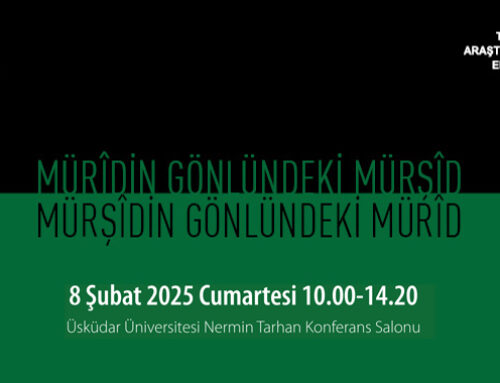Project Description
Sufi Thought and Practices from Past to Present Workshop
Tentative Program
October 7, 2023 Saturday 10.30-15.30
Üsküdar University, Istanbul
10.30 Welcome Speeches
11. 15-12.15 Session 1
Chairperson Daisuke Maruyama
“Sufism, State and the’Ulama: Sufis’ Spiritual Impact During the Ottoman Era”
Reşat Öngören
The Institute for Sufi Studies, Üsküdar University, İstanbul, Turkey
“Sufism: Leadership to the Spiritual World”
Makoto Sawai
Oyasato Institute for the Study of Religion, Tenri University, Nara Japan
Q&A 10 min.
Break 90 min.
13.45-14.45 Session 2
Chairperson Makoto Sawai
“Rumi and Sultan Walad: Sufism in Medieval Period”
Kie Inoue
School of Arts and Letters, Meiji University, Tokyo, Japan
“Adam and Adamiyyet in the Divan of Niyâzî-i Mısrî (d. 1694)”
H. Dilek Güldütuna
The Institute for Sufi Studies, Üsküdar University, İstanbul, Turkey
Q&A 10 min.
Break 15 min.
15.00-16.00 Session 3
Chairperson Kie Inoue
“From a President to an Exemplary Muslim: Political Appropriation of Sufism and its Religious Authority in Sudan”
Daisuke Maruyama
Department of Humanities, National Defense Academy, Japan
“Ramadan Practices from Civilizational Perspective”
F. Cangüzel Güner Zülfikar
The Institute for Sufi Studies, Üsküdar University, İstanbul, Turkey
Q&A 10 min.
Break 15 min.
16.15-17.00 Closing Session
Chairperson Cangüzel Güner Zülfikar
Sufi Thought and Practices from Past to Present Workshop
October 7, 2023
Üsküdar University, Istanbul
Titles with Abstracts of Institute for Sufi Studies participants
“Principles of Sufi Thought in Ottoman Period”
Reşat Öngören
Abstract
It is known that the state of the Ottoman Empire had a close relationship with Sufis since its foundation. This relationship started with Shaykh Edebālī, who married his daughter off to the founder of the state, Osman Ghāzī, and deepened with the assignment of Dāvūd al-Kayserī, the prominent follower of the school of Muḥyī al-Dīn Ibn al-ʿArabī, as the head muderris during the formation of educational institutions, and with his oeuvre on Sufism, which includes his writings and translations during his fifteen-year tenure. These works helped to shape the view of tawhid/the thought of Being in the Ottoman Empire within the perspective of Ibn al-ʿArabī’s thought of waḥdat al-wujud (Oneness of Being), and the thought of “divine love” within the framework of Ibn al-Fārīḍ’s views, and furthermore, by means of the translation of Masnavī of Mawlānā Jalāl al-Dīn al-Rūmī, which took place about a century later, these two understandings were able to spread to wider circles. Thus, from the very beginning, the rulers, members of the ʿulamā’ and the public were brought together within a high-level perception of Sufism shaped even before the Ottoman Empire. This environment caused some outstanding relations within the Palace-madrasa-lodge triangle, and as a natural consequence, works representing a holistic approach in which theology, jurisprudence and Sufism were handled together in the context of the relationship between sharīʾa and ṭarīqa emerged. On the other hand, depending on the perception of jihad of Haji Bektāsh Velī, dervishes facilitated the realisation of conquests by participating in expeditions for jihad against the enemy while continuing jihad against their own nafs. Naturally, this approach led to a close contact between Sufis and the military.
“Sufism: Leadership to the Spiritual World”
Makoto Sawai
Abstract
This presentation aims to consider how Sufism came to obtain spiritual leadership and authority in Muslim society. In the formative period of Sufism, Sufis tried to establish a leading position in their society by demonstrating the difference between Sufism and jurisprudence (fiqh). Before Sufism came into existence, an Arabic term, ʿulama (sing. ʿālim) whose literal meaning is “those who have knowledge” indicates Muslim scholars such as jurists (fuqahāʾ) and theologians (mutaqallimūn). However, Sufis tried to expand the field of knowledge by adding to spiritual knowledge (maʿrifah) and to differentiate it from ordinary knowledge (ʿilm).
In The Book of Light (Kitāb al-Lumaʿ), Ṣarrāj discusses the three sources of Islamic knowledge: the Qur’an, the tradition of the prophet Muḥammad, and the realities of the faith. According to him, these terms correspond to religion (islām), faith (īmān), and good deed (iḥsān). Each of faith and good deed has both sides of the outer (ẓāhir) meaning and the inner (bātin) one. Moreover, Qushayrī demonstrates the “language of the ordinary knowledge” (lisān al-ʿilm) as well as the “language of the subtle” (lisān al-ishārah) in Laṭā‘if al-ishārāt, his exegesis of the Qur’an. Moreover, they think that their knowledge is inherited from the prophet Muḥammad and caliphs. In other words, spiritual or hidden knowledge by them was held before Sufis acquired through the divine unification. They tried to authorize Sufism by referring to the prophets and caliphs and claiming that they were spiritual leaders and inheritors in Muslim society. This tendency was already shown in the thought and Ḥakīm Tirmidhī and flourished in Ibn ʿArabī’s idea on sainthood.
“Saints as a Successor to the Prophets: The Case of Rumi and Sultan Walad”
Kie Inoue
Abstract
The issue of prophets and saints has always been at the center of discussions in Sufism. Prophets and Saints have always had a special status that distinguished them from laymen. One of the most problematic issues when discussing these special people in the context of Islam is the treatment of those who are called “Saints.” This is because the prophet Muhammad is regarded as the seal of prophethood, and the cycle of prophethood is said to have come to an end with Muhammad, so that from that time onward, anyone with any kind of religious charisma was inevitably categorized as a Saint. Therefore, the category of saints itself has functioned as a very ambiguous framework for classification.
Against this background, from around the 13th century, prophets and saints began to be discussed in parallel, and the boundary between the two became blurred. For example, Ruzbihan, a Sufi active in a city in southern Iran, is a representative of this trend. Later, this idea came to fruition as the theory of “the Saint as the successor of the Prophets.” The concept of the Saints as successor to the Prophets was especially developed by Ibn ʿArabi.
Rumi, who lived at about the same time as Ibn Arabi, also treated the roles of Prophets and Saints as equivalent. This tendency was also inherited by Rumi’s son, Sultan Walad. However, Sultan Walad goes beyond mere inheritance this theory and further relates the role of the Saints as the successor to the Prophets to his actual position in the order. By regarding the image of the saints as the actual shaykhs of the order, Sultan Walad links the saints in the history of Sufism with the shaykhs of the order.
“Adam and Adamiyyet in the Divan of Niyâzî-i Mısrî (d. 1694)”
H. Dilek Güldütuna
Abstract
In the Adam chapter, which is the first chapter of his famous work, Fusus al-Hikam, Ibn Arabi depicts the fundamental human qualities in the person of the first human and the first prophet Adam and describes in detail the human’s relation with the universe and God. This study will examine the Divan of Niyazi Mısrî, one of the most important representatives of the Akbari tradition, in the context of the chapter on Adam.
” From a President to an Exemplary Muslim: Political Appropriation of Sufism and its Religious Authority in Sudan”
Daisuke Maruyama
Abstract
My presentation aims to reveal how the Bashir regime sought to legitimize its own authority through the logic of Sufism, using the “Encyclopedia of People Reciting [God’s Name]” compiled at the initiative of the government in 2004. While the encyclopedia is positioned as an extension of the Biographies on Saints, the Righteous, Scholars, and Poets (compiled around 1804/5), a collection of biographies and anecdotes of Sufis active in the Funj (1604-1821), it is characterized by the fact that presidents and former presidents, and even politicians, are listed alongside prominent Sufis. This presentation will focus on the intent of the compilation of the encyclopedia and the content of the politicians’ biographies, and will examine how presidents and politicians sought to authorize themselves religiously as “saints” of sorts. In relation to the above point, in the light of this political context surrounding Sufism, this presentation also intends to analyze the strategies and attempts employed by the Islamist government to reconcile, reinterpret and exploit Sufism and its related issues in accordance with its ideology.
“Ramadan Practices from Civilizational Perspective”
F. Cangüzel Güner Zülfikar
Abstract
Regarding the human as the keystone forming civilization, Sâmiha Ayverdi operates in accordance with the hadith, “the one who sleeps when their neighbor lies hungry is not of us,” and particularly emphasizes the month of Ramadan. Demonstrating the importance of Ramadan for Ottoman-Turkish society, Ayverdi speaks about how the unity that is inherent to Islam manifests within the societal structure, particularly during Ramadan where there is an opportunity to overcome the separations of class, society, and economy. From Ayverdi’s perspective, the additional benefit to Ramadan is that it is also a time where not only the differences among the various parts of society are removed, but there is a cleansing ongoing within the individual human as well. Evaluating Ramadan as a time when the relation of the individual with another individual, with society, with the universe, and with God is gradually strengthened, Ayverdi gives examples from the various traditions that were prevalent at that time, and which are unfortunately close to forgotten now. As such, not only does Sâmiha Ayverdi depict and thus transmit the traditions of the past, she also provides the guide for how we can reach that level of awareness, solidarity, and community today.





